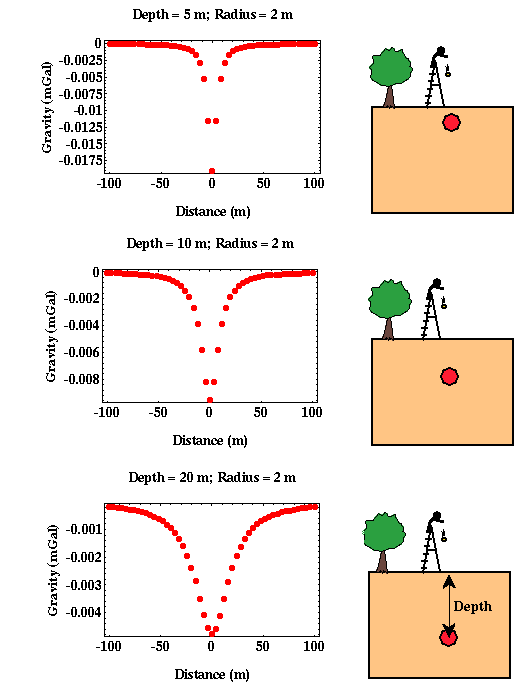Sources of the Local and Regional Gravity Anomalies
Notice that the Regional Gravity Anomaly is a slowly varying function of position along the profile line. This feature is a characteristic of all large-scale sources. That is, sources of gravity anomalies large in spatial extent (by large we mean large with respect to the profile length) always produce gravity anomalies that change slowly with position along the gravity profile. Local Gravity Anomalies are defined as those that change value rapidly along the profile line. The sources for these anomalies must be small in spatial extent (like large, small is defined with respect to the length of the gravity profile) and close to the surface.
As an example of the effects of burial depth on the recorded gravity anomaly, consider three cylinders all having the same source dimensions and density contrast with varying depths of burial. For this example, the cylinders are assumed to be less dense than the surrounding rocks.

Notice that at as the cylinder is buried more deeply, the gravity anomaly it produces decreases in amplitude and spreads out in width. Thus, the more shallowly buried cylinder produces a large anomaly that is confined to a region of the profile directly above the cylinder. The more deeply buried cylinder produces a gravity anomaly of smaller amplitude that is spread over more of the length of the profile. The broader gravity anomaly associated with the deeper source could be considered a Regional Gravity Contribution. The sharper anomaly associated with the more shallow source would contribute to the Local Gravity Anomaly.
In this particular example, the size of the regional gravity contribution is smaller than the size of the local gravity contribution. As you will find from your work in designing a gravity survey, increasing the radius of the deeply buried cylinder will increase the size of the gravity anomaly it produces without changing the breadth of the anomaly. Thus, regional contributions to the observed gravity field that are large in amplitude and broad in shape are assumed to be deep (producing the large breadth in shape) and large in aerial extent (producing a large amplitude).
Gravity
- Overviewpg 12
- -Temporal Based Variations-
- Instrument Driftpg 13
- Tidespg 14
- A Correction Strategy for Instrument Drift and Tidespg 15
- Tidal and Drift Corrections: A Field Procedurepg 16
- Tidal and Drift Corrections: Data Reductionpg 17
- -Spatial Based Variations-
- Latitude Dependent Changes in Gravitational Accelerationpg 18
- Correcting for Latitude Dependent Changespg 19
- Vari. in Gravitational Acceleration Due to Changes in Elevationpg 20
- Accounting for Elevation Vari.: The Free-Air Correctionpg 21
- Variations in Gravity Due to Excess Masspg 22
- Correcting for Excess Mass: The Bouguer Slab Correctionpg 23
- Vari. in Gravity Due to Nearby Topographypg 24
- Terrain Correctionspg 25
- Summary of Gravity Typespg 26